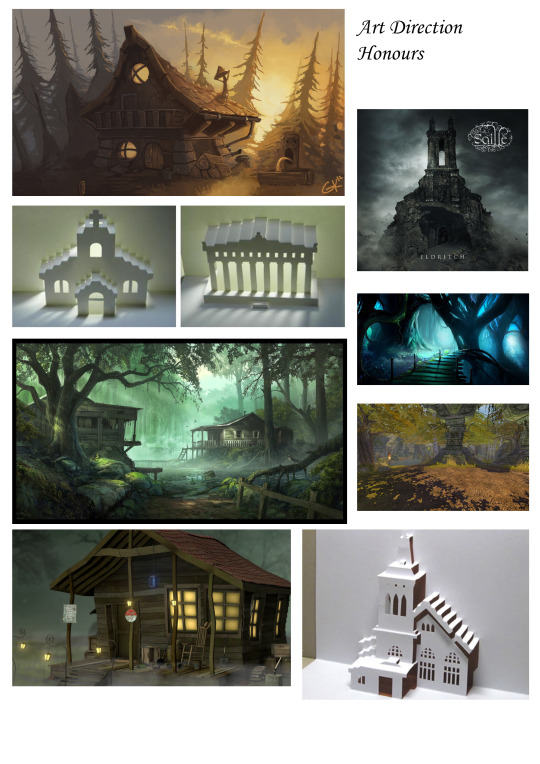Don't wanna be here? Send us removal request.
Text
Player Immersion Choices
The choice to use no-names and other than the intro & outro screens to use entirely first person language was purposeful. The game aims to create as few buffers between the player and the main character, so they are more engaged with the narrative and consequences.
0 notes
Photo

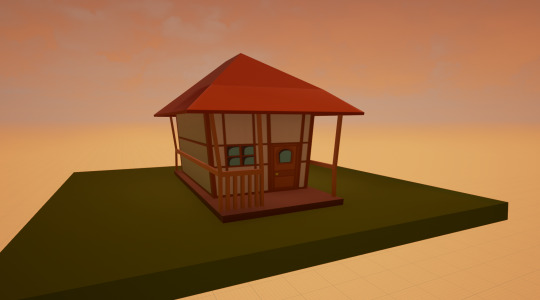
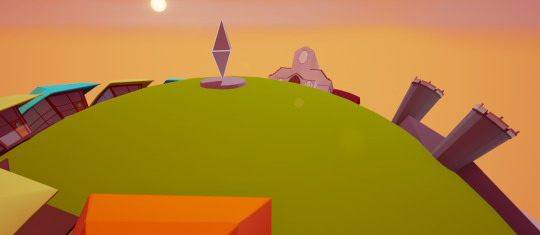
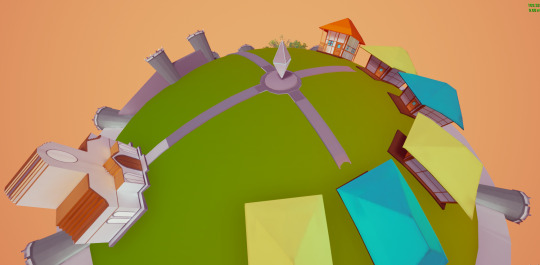
Art Style Development
Concept art was developed using flat vibrant colours as a base and then using slight darker tones for shadows. This style was easy to produce and mass develop across all of my major assets. It also adds vibrance the world that pairs well with the narrative of the game being home in eyes of a young adult. When the player looks out of the inside of the buildings they get to see the more of what the world actually looks like. This is mirrored in the narrative by the game having darker more realistic tones running under the story of self discovery.
0 notes
Text
Case Study: Firewatch
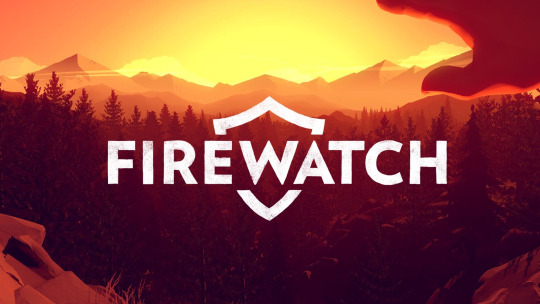
Firewatch: A narrative first person adventure game developed by Campo Santo released February 9th 2016. The story follows a volunteer lookout in the aftermath of the Yellowstone fires of 1988. The narrative contains several underlying personal issues like isolation and mental health.
The reason i'm writing about Firewatch is because of how it uses it small mechanics effectively to help the narrative all the way through the game. Firewatch feels like the successor to Gone Home in the way it is written and paced, however the extra mechanics allow in my opinion for it to be even more effective.
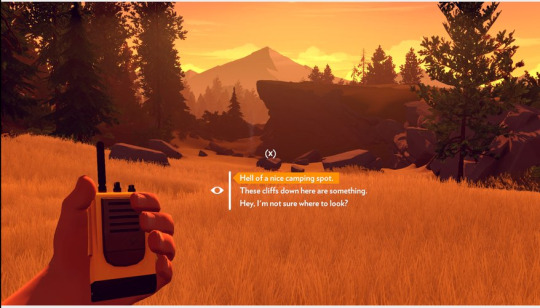
The Radio:
The Radio is the key to what separates Firewatch from Gone Home, it has the ability to link the player to the characters at any time they want, the player has a direct link to the narrative that they control how it's delivered to them.
Initiating conversation:
Like previously mentioned the radio gives the player almost complete control of the pace that the narrative gets delivered to them. The only time the player doesn't get to start the conversation is during big story parts and it feels natural to accept the call and respond.
Picking what you want to say:
This is also important to note, because it follows the same theme of giving the player control over the narrative. So along with initiating conversation the game allows you to choose your response which might even be to not respond at all. This allows players to get specific information or indulge in personal ideas about what's happening in game. Not only this, by having the player choose what they want to say, the player becomes more connected to the main character. This makes big twists and anything that impacts the player character have more of an affect on the player.
Overall Firewatch uses its mechanics in clever ways to help the narrative and in doing so in my opinion makes the story more engaging.
1 note
·
View note
Text
Mechanic Design: Time
The main mechanic that runs through the game is the concept of time. From start to end there is a set game time of about 10 minutes that ticks down on the player screen. This is to represent the characters countdown towards her communion. Once the countdown is over the ending is triggered, which depends on what decisions the player has made up to that point.
These decisions are contained within character communication to NPC’s, for example how their conversation ends and in what scenario you are talking to them ie; their Location, the game time and who you have already spoken to.
Player Agency: Having the game tick-down creates scenarios where the player must make a decision of what they should do first, they know the time doesn't allow them to do everything so what they prioritise is there choice. On additional playthroughs this will have more impact because they are more aware of the game (constraints, story, mechanics etc). This also allows context to be delivered at a natural speed because they receive it as a direct response to their choices.
Narrative: This mechanic works quite well with the narrative of the game. Both the player and character working towards the end, with only a set amount of time to do so. When the amount of time is low and there are things still to do the player feels that panic that the character would also feel. The games goal is for freedom of choice and the time pressure adds more impact to the choices that are made.
0 notes
Text
The personal restriction of GameMaker Studio
For my honours project i initially came to the conclusion that the prototype i wanted to build was best for suited for 2D. Using dialog trees and easy to explore open world made 2D look like the best option. Similar to classic games like Earthbound, Chrono Trigger and the original Zelda’s. So i decided to use an engine that was completely new to me but was good at building 2D games quickly and GameMaker Studio is one of the better options to do this.
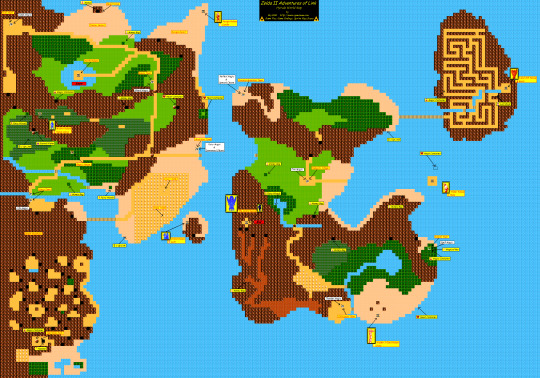
Initial testing was effective, i was able to make simple platforming within a very small amount of time and found the programming system easy to pick up and use.
The biggest issue in initial production was creating a main mechanic that thematically worked with the narrative around it. Initially it was going to be a platforming mini game that the goal of the area was the answer the character gave in the dialog tree. However in practice it didn't feel natural and had the ability to be frustrating and overall unwanted. But i still wanted a main mechanic that helped tie the player and character together. It also created a buffer between the players choice and the result, which separated the player and character which is not what i wanted to happen.
So i revisited my initial plan for the prototype, and it became harder to commit to an idea in engine i am not familiar with. Which led to fighting between game style and a solid mechanic, i didn’t want to sacrifice either option. It wasn’t until i remembered an early idea about using player time to trigger events that i remembered a way that i could build in 3D and have it still feel the same as games i have already listed.
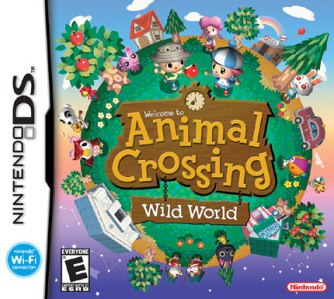
This has led the project back to an engine i know (UE4) and away from GameMaker Studio. The main mechanic is now planned to be time, which i will write about in a future post, and thematically an Animal Crossing esque world design works really well. Helping tie the player to the character since that is all the character knows, the village is there whole world.
Overall i believe the decision to use GameMaker was the right choice at the time, just as i also believe it is the right choice to not use it anymore. Personal restriction and changes in the project moved me away from it.
2 notes
·
View notes
Text
Honours Project: Writing for mechanics
My honours project is planned on being a short game that aims to use both the narrative in the game hand in hand with the mechanics. They are supposed to support each other and give extra life to one another.
To start off i decided i would write some conversation and have an overarching narrative before working with the mechanic side of it. This workflow has worked well so far, it has kept the 2 main focuses together because the mechanic ideas have come clearer while i was writing the initial character conversations. Another design technique i am using is one that ‘ICO’ initially used which is to create a lot and then remove most to help get the core of the game. I am doing that with the writing by going through it multiple times over and removing the unnecessary. I am hoping this makes the characters easier to connect to and the relationship between each other.
To keep it all organised i have been transferring my hand written work to Twine this allows me to visualize the game flow much easier while also gives opportunity to re-write and improve upon it.
The next stage is to bring this into engine and build the base mechanics for a working prototype. After this both mechanic and writing will be done simultaneously.
0 notes
Text
Case Study: The Beginners Guide
The Beginner's Guide is an interactive storytelling video game created by Davey Wreden under the studio name Everything Unlimited Ltd.
My honours project is going to be a heavy narrative design based game that uses its mechanics to heavily reinforce that. Because of this i think it is definitely important to talk about a little game called ‘The Beginners Guide’
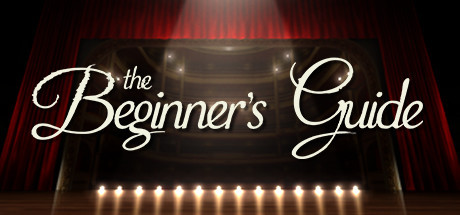
I will be avoiding spoilers due to it being only days old at this point in time and it is very much the type of game that has a personal impact that is worth playing for that unique experience. And that is exactly what the game is, an experience. The game takes you on a very personally journey through someones work that the player connects to.
On a purely technical level The Beginner's Guide is practically a master class in level design to provoke emotional responses. It uses this and the story-line that flows with it to create almost an emotional mirror that you see yourself in. And that's the most beautiful thing about this game is the level of personal contact that you make to it without realizing.
Its a game that left me feeling shell-shocked, thinking about my own life in ways that are not entirely comfortable. It hits the weak-spots and not just in me, i've seen and spoken to several people who fall down that rabbit hole of self reflection and personal feeling. Its surprising, impressive and really is a one of a kind. It stands alone, and did something that have never experienced before in this format.
2 notes
·
View notes
Text
Honours Project: Initial Ideas (9/24/2015)
Aims:
To make a short, single player, narrative focused game.
To use a strong setting/ fiction to support the narrative
The game to be playable and presentable
Interesting main mechanic that supports the narrative
Initial Concept: 'The life you are born into doesn't have to be the life you live'
The idea is that you are playing a trope character within a low fantasy setting ( Wizard, Barbarian, Elven archer, etc) and the character doesn't actually want to become what everyone around them wants them to be. The player has to interact with the people around them and chose a path for the character. These choices can be represented within a tech tree. Which can lead to a different ending and a different life for the character.
Key Ideas:
Tech tree that is linked to the narrative and the character.
Text speech with options (Similar to Kentucky Route Zero)
The Setting is Low Fantasy
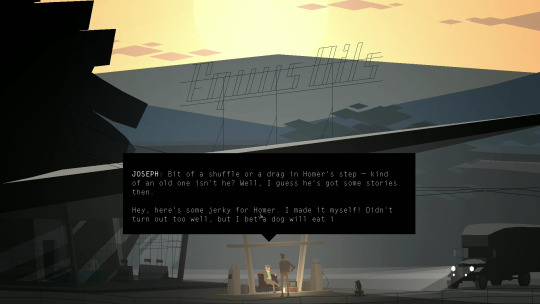
0 notes
